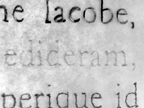Michael Maranda
Quid
79 drawings, each 30x90cm
graphite on vellum
1998–
statement . . .
In 1581, Francisco Sanches — Portuguese philosopher and doctor, marranos, and professor at the University of Toulouse — published Quod Nihil Scitur, a running commentary and refutation of the thought of Aristotle. Widely known
as “Sanchez le sceptique,” this work led the conservative Dutch philosopher Martin Schoock and equally conservative
German theologian Gabriel Wedderkopff to consider him what today would be called “Public Enemy Number 1.”
(See Limbrick, “Introduction”)
Sanches opens his text as follows, “I do not know even this one thing, namely that I know nothing … [et cetera et cetera],”
(Thomson, p.172) and follows through with an argument meant to undercut any and all establishing of the possibility of
‘truth’. Unlike his follower, Descartes, he does not arrive at any safety valve from which to build an epistemology.
His scepticism is, to put it succinctly, thorough, closing the text with “QUID?” which the preface to the
1636 Toulouse edition describes as Sanches’ ‘obelisk’ — referring to the practice of printers marking
a passage in classical texts whose source is either totally uncertain or incomprehensible with an icon of an obelisk.
(Limbrick, p.3) Thus, I prefer to read this ‘quid’ with an argumentative rather than interrogatory inflection,
‘What!’ rather than ‘What?’
Does Sanches succeed in proving that nothing can be known? I could not say, honestly, although his rhetorical strategy
is constructed in such a manner that no matter how one answers this question, his case is proven — either you ‘get’
the argument and thus agree, or you don’t, and indirectly prove him right. His argument is not so much a proof as
the constant stressing of the logical ambiguity of his own proposition. In any case, for present purposes, the matter
is moot. I do not presenting the work of Sanchez as proof of any particular epistemological position. If I were interested
in that, I would have drawn the translated version in whole, in English or French or Spanish or even Portuguese, with
the belief that this would be more readily accessible than the Latin version.
The work itself is simple. A drawing in 79 parts, a rendering of portions of the 1988 Latin-English critical
edition of Quod Nihil Scitur. Each drawing corresponds to a page in the 1988 text, including title pages, cataloguing-in-publication
data page, and the reprinting of the Latin text (but not, of course, the translation). These drawings are rendered in
graphite on single sided drafting vellum, 60x90cm2.
I want to stress that this work is indeed drawing — not writing. I cannot read Latin, and even if I could, the process
by which this work was produced would negate the possibility of it being a transcription. The motivation of this present
work could be considered as a response to the resolution of a question concerning my previous project, “History
[aufhebung],” which certainly looked much more like ‘what a drawing should look like’ but was,
indeed, writing. After making 1,540 writings that looked like drawings I wanted to draw, and not write. «Quid»
is, however, like Aufhebung [history], a continuation of a process of considering the tradition of Western metaphysics
through the materiality of the written and printed text.
Selected Bibliography on Sanchez . . .
Sanchez, Francisco. Quod Nihil Scitur. Lugduni:
apud Antonium Gryphium, 1581.
Schook, Martin. De scepticismo pars prior, sive libri quatuor. Groningae: ex officina Henrici Lussindi, 1652.
Wedderkopf, Gabriel. Dissertationed duae quarum prior do Scepticismo profano et sacro
praecipue remonstrantium, posterior de Atheismo praeprimis Socinianorum. Argentorati: ex officina Josiae Staedelii, 1665.
Sanchez, F. “Que Nada Se Sabe,” trans. Basílio de Vasconcelos in
Francisco Sanches. Prefácio e Selecção. Lisbon:
SNI, 1948 [1913-16].
________. Que Nada Se Sabe. Trans. Jaime Torrubiano.
Madrid: Espasa-Calpe, 1972 [n.d.].
________. Il n’est science de rien. Trans.
Andrée Comparot. Paris: Klincksieck, 1984.
________. That Nothing is Known (Quod Nihil Scitur).
Ed. and intro. Elaine Limbrick, trans. Douglas F.S. Thomson. Cambridge: Cambridge University Press, 1988.
exhibitions . . .
2004
• 2 person. “Traductions,” Galerie Occurence (Montréal)
